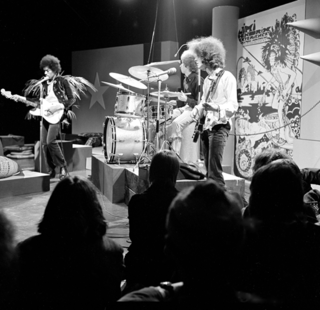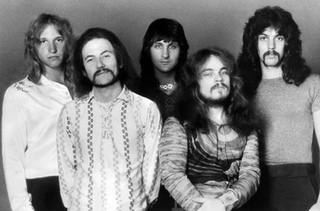Related Research Articles
Heavy metal is a genre of rock music that developed in the late 1960s and early 1970s, largely in the United Kingdom and United States. With roots in blues rock, psychedelic rock and acid rock, heavy metal bands developed a thick, monumental sound characterized by distorted guitars, extended guitar solos, emphatic beats and loudness.

Led Zeppelin were an English rock band formed in London in 1968. The group comprised vocalist Robert Plant, guitarist Jimmy Page, bassist and keyboardist John Paul Jones, and drummer John Bonham. With a heavy, guitar-driven sound, they are cited as one of the progenitors of hard rock and heavy metal, although their style drew from a variety of influences, including blues and folk music. Led Zeppelin have been credited as significantly impacting the nature of the music industry, particularly in the development of album-oriented rock (AOR) and stadium rock.
Hard rock or heavy rock is a heavier subgenre of rock music typified by aggressive vocals and distorted electric guitars. Hard rock began in the mid-1960s with the garage, psychedelic and blues rock movements. Some of the earliest hard rock music was produced by the Kinks, the Who, the Rolling Stones, Cream, Vanilla Fudge, and the Jimi Hendrix Experience. In the late 1960s, bands such as Blue Cheer, the Jeff Beck Group, Iron Butterfly, Led Zeppelin, Golden Earring, Steppenwolf, and Deep Purple also produced hard rock.

A power trio is a rock and roll band format having a lineup of electric guitar, bass guitar and drum kit, leaving out a dedicated vocalist or an additional rhythm guitar or keyboard instrument that are often used in other rock music bands that are quartets and quintets. Larger rock bands often use one or more additional rhythm sections to fill out the sound with chords and harmony parts.

Blues for the Red Sun is the second studio album by American rock band Kyuss, released in 1992. While the album received mainly favorable reviews, it fared poorly commercially, selling only 39,000 units. It has since become a very influential album within the stoner rock genre. It was the last Kyuss album to feature bassist Nick Oliveri, who was replaced by Scott Reeder shortly after recording had been completed. The album is dedicated to Oliveri's father who died in a car accident in 1991.
Acid rock is a loosely defined type of rock music that evolved out of the mid-1960s garage punk movement and helped launch the psychedelic subculture. While the term has sometimes been used interchangeably with "psychedelic rock", acid rock also specifically refers to a more musically intense, rawer, harder, louder, or heavier subgenre or sibling of psychedelic rock. Named after lysergic acid diethylamide (LSD), the style is generally defined by heavy, distorted guitars and often contains lyrics with drug references and long improvised jams.
Blues rock is a fusion genre and form of rock music that relies on the chords/scales and instrumental improvisation of blues. It is mostly an electric ensemble-style music with instrumentation similar to electric blues and rock. From its beginnings in the early to mid-1960s, blues rock has gone through several stylistic shifts and along the way it inspired and influenced hard rock, Southern rock, and early heavy metal.

"Born to Be Wild" is a song written by Mars Bonfire and first performed by the band Steppenwolf. It is often invoked in both popular and counter culture to denote a biker appearance or attitude. It is most notably featured in the 1969 film Easy Rider. Sometimes, "Born to Be Wild" is described as the first heavy metal song, and the second-verse lyric "heavy metal thunder" marks the first use of this term in rock music.

"Shapes of Things" is a song by the English rock group the Yardbirds. With its Eastern-sounding, feedback-laden guitar solo and environmentalist, anti-war lyrics, several music writers have identified it as the first popular psychedelic rock song. It is built on musical elements contributed by several group members in three different recording studios in the US, and was the first Yardbirds composition to become a record chart hit; when released as a single on 25 February 1966, the song reached number three in the UK and number eleven in the US.

Granicus was an American hard rock band formed in 1969 in Cleveland. After performing in clubs in Cleveland, and then playing before label bosses, the band were then later signed by RCA Records on March 15, 1973 and released their eponymous debut album in the same year. The band later opened for such performers as Bob Seger, Cactus and Spirit to promote that first record, which has since been critically acclaimed in some classic rock circles. Soon after, though, the group disbanded, feeling unsupported by their label and being deserted by their manager. Most of the group later reunited, some 25 plus years later, after finding their first record pirated and selling in Europe. In 2009, they released Thieves, Liars and Traitors on an independent label in 2010. from a collection of unreleased material recorded in 1974. A third record, Better Days, has also since been released independently. The group was known for their mix of heavy blues rock, progressive rock, psychedelic rock and heavy metal.
Chris Welch is an English music journalist, critic, and author who is best known for his work from the late 1960s as a reporter for Melody Maker, Musicians Only, and Kerrang!. He is the author of over 40 music books.
This is a timeline documenting the events of heavy metal in the year 1970.
Freddy Bannister, sometimes written as Freddie Bannister, was a leading British concert promoter during the 1960s and 1970s, and was the founder of the Bath Festival of Blues 1969, the Bath Festival of Blues and Progressive Music 1970 and the Knebworth festivals.

Outsideinside is the second album by American power trio Blue Cheer. Philips Records released the album in August 1968, only seven months after their debut LP, Vincebus Eruptum.

The Yardbirds are an English rock band, formed in London in 1963. The band started the careers of three of rock's most famous guitarists: Eric Clapton (1963–1965), Jeff Beck (1965–1966) and Jimmy Page (1966–1968), all of whom ranked in the top five of Rolling Stone magazine's list of 100 greatest guitarists. The band's other members during 1963–1968 were vocalist/harmonica player Keith Relf, drummer Jim McCarty, rhythm guitarist Chris Dreja, and bassist Paul Samwell-Smith, with Dreja switching to bass when Samwell-Smith departed in 1966. The band had a string of hits throughout the mid-1960s, including "For Your Love", "Heart Full of Soul", "Shapes of Things", and "Over Under Sideways Down".
Metal Evolution is a 2011 documentary series directed by anthropologist and filmmaker Sam Dunn and director, producer and music supervisor Scot McFadyen about heavy metal subgenres, with new episodes airing every Friday at 10 pm EST on MuchMore and Saturday at 10pm EST on VH1 Classic. Its origins come from Dunn's first documentary Metal: A Headbanger's Journey, which included the acclaimed "Heavy Metal Family Tree."

Heavy metal guitar is the use of highly-amplified electric guitar in heavy metal. Heavy metal guitar playing is rooted in the guitar playing styles developed in 1960s-era blues rock and psychedelic rock, and folk harmonic traditions and it uses a massive sound, characterized by highly amplified distortion, extended guitar solos and overall loudness. The electric guitar and the sonic power that it projects through amplification has historically been the key element in heavy metal. The heavy metal guitar sound comes from a combined use of high volumes and heavy distortion.
This is a timeline documenting the events of heavy metal in the year 1969.
This is a timeline documenting the events of heavy metal in the year 1968.
References
- Barnet, Richard D.; Burriss, Larry L. (2001). Controversies of the Music Industry. Westport: Greenwood Publishing Group. ISBN 0-313-31094-7.
- Borthwick, Stuart; Moy, Ron (2004). Popular Music Genres: an Introduction. Edinburgh: Edinburgh University. ISBN 0-7486-1745-0.
- Bukszpan, Daniel (2003). The Encyclopedia of Heavy Metal. New York: Barnes & Noble Publishing. ISBN 0-7607-4218-9.
- Buckley, Peter (2003). The Rough Guide to Rock . London: Rough Guides. ISBN 1-84353-105-4.
- Crocker, Chris (1993). Metallica: The Frayed Ends of Metal. New York: St. Martin's Press. ISBN 0-312-08635-0.
- De Leon, David (1994). Leaders from the 1960s . Westport: Greenwood Publishing Group. ISBN 0-313-27414-2.
- Everett, Walter (2008). The Foundations of Rock: From "Blue Suede Shoes" to "Suite: Judy Blue Eyes". Oxford: Oxford University Press. ISBN 0-19-531023-3.
- Frith, Simon; Goodwin, Andrew (1990). On Record: Rock, Pop, and the Written Word. London: Routledge. ISBN 0-415-05306-4.
- Hoffmann, Frank W.; Howard, Ferstler (2005). Encyclopedia of Recorded Sound. New York: Routledge. ISBN 0-415-93835-X.
- Walser, Robert (1993). Running with the Devil: Power, Gender, and Madness in Heavy Metal Music . Hanover: Wesleyan University Press. ISBN 0-8195-6260-2.
- Weinstein, Deena (2000). Heavy Metal: the Music and its Culture. New York: Da Capo Press. ISBN 0-306-80970-2.
- Buckley, Peter (2003). The Rough Guide to Rock. London: Rough Guides. ISBN 1-85828-201-2.